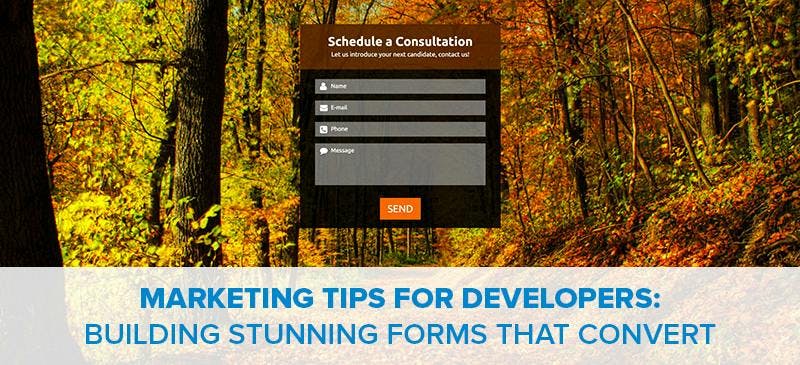Typically developers take on the responsibility of a company’s online forms. Payment forms, lead collection forms, registration forms, onboarding processes — developers code the forms then collect and store the data.
Perhaps you’d like to integrate with products like SalesForce or Constant Contact. Or, you’d like to add payment options like PayPal and Stripe.
Anything you do to enhance form conversions could pay dividends for your business, and that’s where some developers can learn some marketing best practices that might come in handy.
Marketers have lots of insight and are familiar with important considerations to keep in mind for better performing forms. Instead of building just a basic form, their insight can help you create forms that collect the information you need while maintaining the right aesthetics and message that your brand needs to thrive. Marketers are concerned with performance, design, analytics, company brand and strategy. Their customer insights and interests will help them develop the right message and interact with the customer to optimize the form to succeed in a variety of success measures.
As a developer, you’re busy though. You might not have the time to work with marketers or to implement their concepts. If this is the case, you can consider an online form builder like JotForm. It alleviates the need to spend hours coding and designing forms. But if you’d like to optimize the forms on your own, keep reading for tips and best practices for developing forms that align with your marketing goals.
Form Building Best Practice #1: Ask for Only the Minimal Information That Will Still Support Your Objective
Just like building a Minimal Viable Product is all about building the product that has the highest return on investment versus risk, effective form building fits the same ethos. It is a delicate balance between asking for the information you want and not wanting to lose conversions.
For example, asking for a phone number makes form visitors leery. No one wants annoying unsolicited calls. On the same token, asking lots of questions worries them as well. Every additional question could be the straw that breaks the camel’s back. If you’re building an email acquisition form, keep it simple, like in this image:

This is built to fit a brand, has some reasons to fill out the form and uses icons to create a strong visual appearance.
In customer feedback forms, many developers have a tendency to get overly specific in trying to get to the root of an issue. Try to rein in that inclination by asking yourself if it is truly necessary.
If you really want to get more information, present it in a more user friendly way. Instead of asking customers to check a box or select a rating representing their satisfaction for each of many categories, perhaps simple questions and symbol could be used instead.
Consider something like, “How was your experience?” followed by a happy or sad face that could be pressed, with an optional comment field. Allowing the user to convey their satisfaction with their experience with one click reduces the barrier of submitting feedback. Because it’s so easy, you will probably receive a higher conversion rate of responses.
Those who would like to contribute additional information can, but not making it a requirement can give you a broader, general assessment. However, this depends on many variables, and should always be tested.
Best Practice #2 — Test Multiple Versions of Your Form
Make sure to A/B test different versions of at least your most important customer-facing forms. The results could surprise you. Perhaps an important word is illegible on a certain screen setting, or customers respond much better to a more descriptive label on the submit button. You can make your best guess, but you don’t really know until you try.
Submit buttons are very important because you must make the call to action clear. Form visitors should know what to expect when they submit their form, so you may want to consider options other than “Submit.” Will they be signed up for a newsletter? Then how about “Sign Up for Newsletter.” Will it be the last step for online purchasing? Consider “Buy Now” or “Make a Payment.”

An easy way to A/B test your forms is to show 50 percent of your website visitors one version, and the other 50 percent are shown the other version, which is exactly the same but with one difference. If you don’t have a way to measure this, JotForm can give you those analytics. Given a sizable enough sample size, you can evaluate your data and make subsequent tweaks if desired.
Best Practice #3 — What Comes Next? Let Your Form Visitor Know of Next Steps
If the action of submitting your form warrants an automated email message, make it count. It’s appropriate to send emails after someone signs up for your product/service, makes a purchase, or makes an action like downloading something. On the thank you page, let them know they should be looking for an email from a specific email address and that they should check their spam.
Your email should be on brand and reflect your brand’s purpose or personality. Give your user “closure” or recognition that their action has been received.
The purpose of a follow-up message goes beyond practically — yes, it’s informative and helpful to send a “Getting Started” or “How to Get Started” email when people register for a tool or service, and people may want to reference their receipt or tracking number after they make a purchase.
But, this is your chance to make a real impression in your user’s mind. Say something funny or corny, send a short and interesting video, or showcase a feature that could be helpful to that user’s specific needs.
Let them know who they can get in touch with if they have questions. Try to remove buyers remorse and put your customer more at ease with their decision to connect/sign up with/purchase from your company. Also, make it easy for the interaction to continue by featuring your company’s social media profiles.
Concluding Thoughts
These 3 tips should help developers like yourself build terrific forms using marketing best practices. If you’re working with your marketing department or marketing agency or trying to do this on your own, this can become daunting, so give JotForm a try which will empower your marketers to build great forms themselves.

